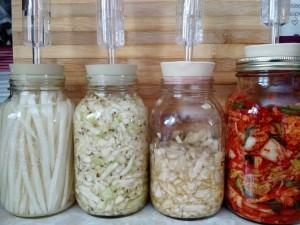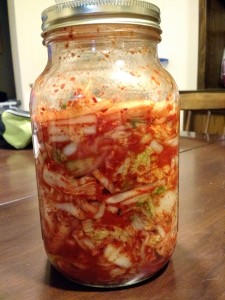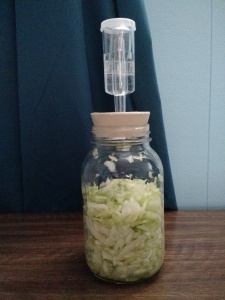This is a guest post from my friend Michelle – enjoy!
I really like to ferment things. I’ve made pickles, yogurt, honey wine, and sauerkraut. I’ve got a continuous brew of kombucha on my counter. I’m trying sourdough. The bubbly goodness makes me a bit giddy. The fact that there are little bacteria at work making food good to eat is enchanting. It grosses some people out, but it’s good stuff.
If you’re concerned about safety and getting sick, you can read up on the whole process.
http://www.extension.umn.edu/food/Food-Safety/preserving/pickling/making-fermented-pickles-and-sauerkraut/
You can also read this.
According to Fred Breidt a microbiologist with the USDA – “properly fermented vegetables are actually safer than raw vegetables, which might have been exposed to pathogens like E. coli on the farm… With fermented products there is no safety concern. I can flat-out say that. The reason is the lactic acid bacteria that carry out the fermentation are the world’s best killer of other bacteria,”- San Francisco Gate, June 2009.
I make sure I’m using clean crocks or jars with no cracks. And I make sure that there are no vegetables sticking up over the brine. More on that later.
One of my favourite fermentation authors (yes, I have favourite fermentation authors) is Sandor Katz. His first book “Wild Fermentation” is very easy and very approachable. He’s got some amazingly simple recipes to get you started. I refer back to him whenever I’m making a ferment for proportions and ideas. (http://www.wildfermentation.com)
There are many, many ways of fermenting. And many, many things you can ferment. I mostly stick to vegetables. With some forays into dairy products (yogurt), and fruit for alcohol. The 3 main methods of fermenting vegetables that I use are a) salting, b) preserving in brine, and c) pre-soaking in brine. For a kim chi style, I’m using the pre-soaking in brine method. For this, I’ll pre soak the vegetables overnight and add the spices to the drained salty vegetables.
I should actually start with sauerkraut, which is basically just cabbage and salt. But I’m not. Sandor Katz has a great how-to on his website. (http://www.wildfermentation.com/making-sauerkraut-2/)
Ready to start?
First I go and look in my fridge and pull out whatever looks good. Today I pulled out red cabbage, carrots, chinese cabbage, green onion, and bok choi. I coarsely chopped these all together and threw them into a crockery bowl. Use something food safe – good options include glass and old style crocks. I do use stainless steel for my prep, but not for the actual fermenting stage. I have used plastic, it’ll work, but if you’re worried about leeching chemicals find something else.

Chopped veggies!
Here’s my mixed and chopped vegetables. It’s a matter of what flavours and textures you think would work well together. In this case, I used about an equal amount of red cabbage, Chinese cabbage, and bok choi leaves. Then I threw in 2 chopped up carrots and 3 chopped up green onions. I also added Kombu strips. This is a seaweed. Good minerals and extra flavour. I cut it up with scissors directly into the veggies.
(Other veggies I have used – swiss chard, beet greens, jerusleum artichokes, radish, dandelion greens & root, parsnips, celery, kale, turnip greens and turnips. Be creative!!!)
Next step is to make your brine. I use coarse salt or sea salt. And tap water. Fresh tap water. This is actually not recommended. It should be de- chlorinated. But I’ve been doing this for several years and haven’t had any problems. Especially with the kim chis. If you want to de-clorinate your tap water, fill a wide mouthed vessel the night before and let it sit overnight. The chlorine will evaporate off.
Use 4 TBSP of salt to every litre of water. Today I used 2 litres of water and 8 TBSP of salt. It will be VERY salty. Pour the brine on the vegetables.
Once that’s all together, cover it with a clean cloth and let it sit overnight in the brine.
The next morning, you’re going to pull together the spices.
This is a “to taste” step. If you like more spice, add more peppers. If you adore garlic, throw it in. I used ginger, garlic, onion, and dried chill peppers. Sometimes for kim chi I add in fermented fish sauce. This is the only time I add an animal product to a ferment. This time I’m making a vegan version, so I omitted it.

Pre-Ninjaed Spices!
Then I “Ninja”ed it. I love my Ninja. You can chop, food process, or otherwise smoosh into small pieces.
Then I turn my attention back to my veggies in brine. I drain off the brine. And taste the veggies. They should be salty, but not TOO salty. Think French Fries. Rinse them off if they’re too salty, add more salt if you don’t find them salty enough.
Then mix the spices with the drained veggies!! Now comes the fun part. Find a glass jar or a crock of the appropriate size. I use mason jars, flip top jars, or glass crocks from Ikea. Today I’ve got a flip top jar. Put the mixture into the jar and press it DOWN. You want it squished. You want a bit of juice on the top. You want to leave some space at the top of the jar. I normally fill 2/3s. You DON’T want any food particles on the side of the jar above the veggies. They will mold. I use spoons, or fingers. But be aware that you’ve just put hot peppers into this.
Almost done! Now you need to weight the veggies. Basically any solids exposed to air will mold. Fermentation = good. Mold = not so good. So we want to get all the veggies below the liquid, while still allowing the gases to escape. (Yes, your ferment will produce gas!) There are all sort of options for this. A clean stone, a plate, a special weight, a fancy dancy air lock system. I use a plastic bag. I like the freezer ziploc bags as they’re sturdy, but will also use sandwich bags for small ferments. Put water in the bag, basically just a little less then the amount you need to fill the space you left in your jar. Again, I use tap water. Now add salt, in about the same proportion that you used for the original brine. That way, if your bag leaks, you’re not diluting your ferment. I used about 2 cups water and 2 TBSP salt. I’m not good at measuring. Then get all the air you can out of the bag, and seal the bag.
Take your bag o’water and squish it into your jar. Squish it until the juice squeezes out the top a little bit and the veggies are not in contact with air. Again, this is important. Veggies in contact with air will mold. Mold isn’t great. Juice is ok in contact with air. Put the jar on a plate, because it will overflow a bit when the fermentation starts, and place it out of the way. I keep it in my kitchen where I can look at it and check it daily.

Ready for fermentation!
Kim Chi takes about a week to “ripen”, but this is temperature sensitive. Warm ferments finish faster, cool ferments slower. Therefore, after the 4th day, start checking it. Pull out the baggie, and taste the ferment. It should be a sour yummy taste. If it’s not sour enough, wash the baggie, put it back in, and let it ferment some more. If you like the flavour, put it in the fridge to slow the ferment.
Big question. How do I know if it’s bad? Smell it a bit. Taste a tiny bit. Do you like what you smell/taste? Then it’s not bad.
Sometime else about mold. Which will just make Violet squirm. I lied a bit. Sometimes a bit of mold is ok. If you get a bit of white mold on the top veggies, cause they were exposed to air, just pick them off and push the rest under the juice and keep going. If you get any other colour mold, then feel free to chuck it.
I like this kim chi as a side to just about anything. Or in an oriental style soup. Or straight out of the jar. I’ll report back when mine is ready and let you know how this batch tastes!






